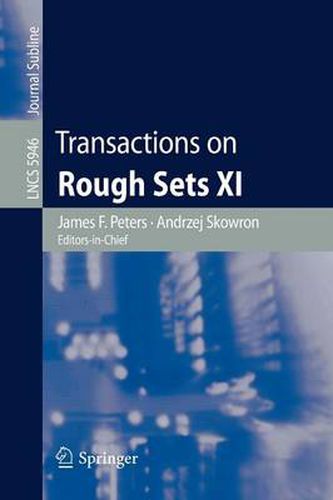Readings Newsletter
Become a Readings Member to make your shopping experience even easier.
Sign in or sign up for free!
You’re not far away from qualifying for FREE standard shipping within Australia
You’ve qualified for FREE standard shipping within Australia
The cart is loading…






This title is printed to order. This book may have been self-published. If so, we cannot guarantee the quality of the content. In the main most books will have gone through the editing process however some may not. We therefore suggest that you be aware of this before ordering this book. If in doubt check either the author or publisher’s details as we are unable to accept any returns unless they are faulty. Please contact us if you have any questions.
Volume XI of the Transactions on Rough Sets (TRS) provides evidence of f- ther growth in the rough set landscape, both in terms of its foundations and applications. This volume provides further evidence of the number of research streams that were either directly or indirectly initiated by the seminal work on rough 1 sets by Zdzis law Pawlak (1926-2006) . Evidence of the growth of various rough 2 set-based research streams can be found in the rough set database . Thisvolumecontainsarticlesintroducingadvancesinthefoundationsand- plicationsofroughsets.These advancesinclude: calculusofattribute-value pairs useful in mining numerical data, de?nability and coalescence of approximations, variable consistency generalization approach to bagging controlled by measures of consistency, classical and dominance-based rough sets in the search for genes, judgementaboutsatis?abilityunderincompleteinformation,irreducibledescr- tive sets of attributes for information systems useful in the design of concurrent data models, computational theory of perceptions (CTP) and its characteristics and the relation with fuzzy-granulation, methods and algorithms of the Net- TRS system, a recursive version of the apriori algorithm designed for parallel processing, and decision table reduction method based on fuzzy rough sets. Theeditorsandauthorsofthisvolumeextendtheirgratitudetothereviewers of articles in this volume, Alfred Hofmann, Ursula Barth, Christine Reiss and the LNCS sta? at Springer for their support in making this volume of the TRS possible.
$9.00 standard shipping within Australia
FREE standard shipping within Australia for orders over $100.00
Express & International shipping calculated at checkout
This title is printed to order. This book may have been self-published. If so, we cannot guarantee the quality of the content. In the main most books will have gone through the editing process however some may not. We therefore suggest that you be aware of this before ordering this book. If in doubt check either the author or publisher’s details as we are unable to accept any returns unless they are faulty. Please contact us if you have any questions.
Volume XI of the Transactions on Rough Sets (TRS) provides evidence of f- ther growth in the rough set landscape, both in terms of its foundations and applications. This volume provides further evidence of the number of research streams that were either directly or indirectly initiated by the seminal work on rough 1 sets by Zdzis law Pawlak (1926-2006) . Evidence of the growth of various rough 2 set-based research streams can be found in the rough set database . Thisvolumecontainsarticlesintroducingadvancesinthefoundationsand- plicationsofroughsets.These advancesinclude: calculusofattribute-value pairs useful in mining numerical data, de?nability and coalescence of approximations, variable consistency generalization approach to bagging controlled by measures of consistency, classical and dominance-based rough sets in the search for genes, judgementaboutsatis?abilityunderincompleteinformation,irreducibledescr- tive sets of attributes for information systems useful in the design of concurrent data models, computational theory of perceptions (CTP) and its characteristics and the relation with fuzzy-granulation, methods and algorithms of the Net- TRS system, a recursive version of the apriori algorithm designed for parallel processing, and decision table reduction method based on fuzzy rough sets. Theeditorsandauthorsofthisvolumeextendtheirgratitudetothereviewers of articles in this volume, Alfred Hofmann, Ursula Barth, Christine Reiss and the LNCS sta? at Springer for their support in making this volume of the TRS possible.